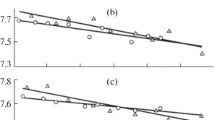Abstract
The effect of oxygen and silicon impurities on the structural and physicochemical properties of the nickel melts is studied in performing evaluations based on the density and surface tension parameters. The behavior of the impurity elements is considered in studying the liquid state of pure nickel and nickel containing 0.005–0.01% silicon and oxygen in the course of refining these melts, in which the compression effect and negative deviations from Raoult’s law are formed. The surface tension of the silicon-containing nickel melt is found to increase with the oxygen concentration. The absorption parameters of a solution abruptly decrease in accordance with the increase in interparticle interaction in the volume and the formation of a strong cluster.





Similar content being viewed by others
REFERENCES
E. N. Kablov, Cast Gas-Turbine Engine Blades (Izd. MISiS, Moscow, 2001).
V. V. Sidorov, V. E. Rigin, O. B. Timofeeva, and P. G. Min, “Effect of silicon and phosphorus on high-temperature properties and structural phase transformations in single crystals of highly heat-resistant alloy VZhMCh-VI,” Aviats. Mater. Teknol., No. 3, 32–38 (2013).
L. M. Shergin, S. I. Popel’, and B. V. Tsarevskii, “Temperature dependence of the density and surface tension of cobalt–silicon, iron–silicon, and nickel–silicon melts,” in Physical Chemistry of Metallurgical Melts, Part III (Knizhnoe Izd., Sverdlovsk, 1971), pp. 52–61.
E. A. Pastukhov, N. A. Vatolin, V. L. Lisin, V. M. Denisov, and S. V. Kichin, Diffraction Studies of the Structure of High-Temperature Melts (Izd. IMET UrO RAN, Yekaterinburg, 2003).
P. V. Gel’d and F. A. Sidorenko, Group IV Transition Metal Silicides (Metallurgiya, Moscow, 1971).
K. S. Filippov, V. T. Burtsev, V. V. Sidorov, and V. E. Rigin, “Surface tension and density of nickel melts containing impurity silicon,” Fiz. Khim. Obrab. Mater., No. 4, 74–78 (2014).
E. S. Filippov and S. I. Filippov, “Theoretical calculation of oxygen–deoxidizing element equilibrium in liquid iron alloys based on critical concentrations,” Izv. Vyssh. Uchebn. Zaved., Chern. Metall., No. 7, 12–17 (1966).
V. N. Epin and L. V. Govorukhin, “Effect of impurity on the electrical resistivity of liquid iron,” in Scientific Reports of IV All-Russia Conference on the Structure and Properties of Metallic and Slag Melts (Sverdlovsk, 1980), Part II, pp. 188–191.
V. V. Sidorov, V. E. Rigin, P. G. Min, Yu. I. Folomeikin, O. B. Timofeeva, E. V. Filonova, and I. V. Iskhodzhanova, “Effect of impurities on the structure and properties of highly heat-resistant casting alloys and development of effective methods of elimination of their negative effect,” Electron. Nauchn.-Tekhn. Zh. Novosti Materialoved. Nauka i Tekhnika, No. 2, 1–18, (2014).
G. N. Elanskii and V. A. Kudrin, Structure and Properties of Liquid Metal—Technology—Steel Quality (Metallurgiya, Moscow, 1984).
I. R. Kryanin, I. L. Mirkin, and L. P. Trusov, “Kinetics of structural transformations and failure of high-temperature alloys upon long-term tests,” Metalloved. Term. Obrab. Met., No. 8, 8–19 (1967).
A. V. Ryabov and E. A. Trofimov, “Improving methods for experimental study of the bismuth solubility in nickel,” Vestn. Yuzhn.-Ural Gos. Univ., Ser. Metall., No. 34, 32–34 (2010).
Ya. E. Gol’shtein and V. G. Mizin, Modification and Microalloying of Cast Iron and Steel (Metallurgiya, Moscow, 1986).
K. S. Filippov and V. V. Molokanov, “Density and surface tension of the melt of an amorphous alloy as a function of the structure of the initial sample,” Russ. Metall. (Metally), No. 3, 187–191 (2013).
A. Sharan and A. W. Cramb, “Surface tension and wettability studies of liquid Fe–Ni–O alloys,” Met. Mater. Trans. B 28 (3), 465–472 (1997).
I. Seyhan and I. Egry, “The surface tension of undercooled binary iron and nickel alloys and the effect of oxygen on the surface tension of Fe and Ni,” Intern. J. Thermophys. 20 (4), 1017–1028 (1999).
V. N. Eremenko and Yu. V. Naidich, “Effect of oxygen on the surface tension of nickel and interfacial angle of alumina with nickel,” Izv. AN SSSR. OTN. Metall. i Toplivo, No. 2, 53–55 (1960).
S. N. Anuchkin, V. T. Burtsev, M. V. Zagumennikov, V. V. Sidorov, and V. E. Rigin, “Study of the surface properties of nickel-based melts by the sessile drop method: II. Density,” Russ. Metall. (Metally), No. 5, 371–374 (2010).
K. S. Filippov, “Density, surface tension, and properties of nickel–oxygen melts,” Russ. Metall. (Metally), No. 5, 563–572 (2020).
Yu. V. Naidich and V. M. Eremenko, “Sessile drop method for the determination of the surface tension and density of liquid metals at high temperatures,” Fiz. Met. Metalloved. 11 (6), 883–885 (1961).
E. S. Filippov, Structure, Physics, and Chemistry of Metallurgical Processes (Metallurgiya, Moscow, 1995).
Funding
This work was carried out in terms of state assignment no. 075-00715-22-00.
Author information
Authors and Affiliations
Corresponding author
Ethics declarations
The author declares that he has no conflicts of interest.
Additional information
Translated by N. Kolchugina
Rights and permissions
About this article
Cite this article
Filippov, K.S. Effect of Oxygen and Silicon Impurities on the Structural and Physicochemical Properties of the Nickel Melts. Russ. Metall. 2022, 1050–1058 (2022). https://doi.org/10.1134/S0036029522090063
Received:
Revised:
Accepted:
Published:
Issue Date:
DOI: https://doi.org/10.1134/S0036029522090063




